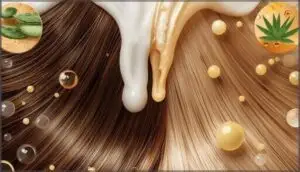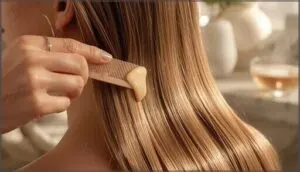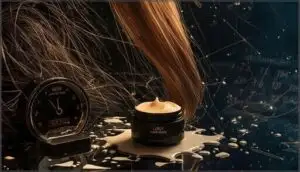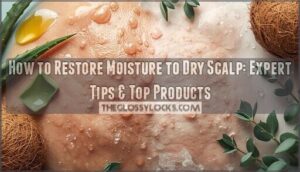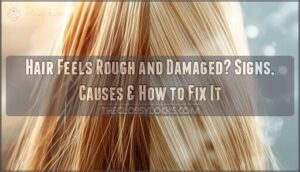This site is supported by our readers. We may earn a commission, at no cost to you, if you purchase through links.
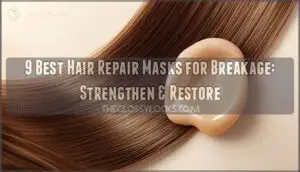
Disulfide bonds—the protein bridges that give hair its strength—fracture under heat styling, chemical treatments, and environmental stress.
Hair repair masks target these broken bonds directly, delivering concentrated proteins, moisture-binding agents, and bond-building technology that penetrate the cortex where damage lives. The right formulation doesn’t just coat your hair with temporary slip. It rebuilds what breakage destroys from the inside out, restoring tensile strength and elasticity that keep strands intact through styling, weather, and daily wear.
Table Of Contents
- Key Takeaways
- Best Hair Repair Masks for Breakage
- 1. Oribe gold lust hair masque treatment
- 2. Hydrating Mask for Dry Hair
- 3. Molecular Hair Mask for Damage
- 4. Virtue Flourish Thinning Hair Mask
- 5. amika soulfood nourishing hair mask
- 6. Deep Conditioning Hair Repair Mask
- 7. SheaMoisture hair repair deep moisturizing masque
- 8. Hydrating Hair Repair Treatment Mask
- 9. Olaplex intense moisture hair mask
- Key Ingredients for Breakage Repair
- How Hair Masks Prevent and Repair Breakage
- Choosing The Right Hair Mask for Your Needs
- Tips for Effective Hair Mask Application
- Frequently Asked Questions (FAQs)
- Conclusion
Key Takeaways
- Hair repair masks rebuild broken disulfide bonds and protein structures at the molecular level, delivering measurable results like 30-50% increases in tensile strength and up to 76% reduction in breakage with consistent weekly use.
- The most effective formulas combine bond-building peptides (like bis-aminopropyl diglycol dimaleate), hydrating oils that penetrate the cortex (coconut, argan), and keratin complexes that can boost breaking force by 136% while sealing the cuticle against future damage.
- Your hair type dictates application strategy—fine hair needs lightweight, protein-sparing treatments applied biweekly, while thick and curly textures benefit from richer, moisture-heavy masks 1-2 times weekly for 15-30 minutes.
- Application technique matters as much as ingredients: apply to towel-dried (not soaking wet) hair from mid-lengths to ends, use heat or wraps to open the cuticle for deeper penetration, and avoid overuse beyond recommended frequency to prevent protein buildup that causes stiffness.
Best Hair Repair Masks for Breakage
Hair breakage doesn’t happen overnight—it’s the result of cumulative damage from heat, chemicals, and environmental stress. The right repair mask rebuilds your hair’s internal structure while sealing moisture back into weakened strands.
Here are nine clinically effective formulations that address breakage at the molecular level.
1. Oribe gold lust hair masque treatment
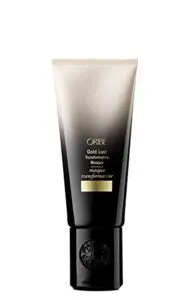
Oribe Gold Lust Repairing Masque delivers luxury haircare that rebuilds broken strands from within. This hair breakage treatment uses bond-building technology with biotin, caffeine, and plant collagen to fortify each fiber while baobab oil and shea butter restore elasticity.
Clinical trials show 86% of users reversed visible damage in seven days. You’ll find this damaged hair treatment strengthens the cuticle, reduces split ends, and adds dramatic softness—though the $69 price reflects its premium positioning.
It’s formulated without parabens or sulfates, making it suitable for color-treated hair needing intensive hair restoration and hair strengthening benefits.
Best For: Anyone with severely damaged, overprocessed, or chemically-treated hair who wants professional-level repair and can invest in premium treatment.
- Clinical results show 86% of users reversed visible damage in just one week, with dramatic improvements in softness and hydration
- Advanced formula with plant collagen, biotin, and baobab oil rebuilds broken strands while being safe for color-treated and keratin-treated hair
- Free from parabens and sulfates, cruelty-free, and works as both deep conditioning treatment and bond-building therapy
- Premium price of $69 makes it one of the most expensive hair masks on the market
- Some users report quality control issues with products arriving opened or appearing used
- Requires significant time commitment (15-30 minutes minimum per treatment) for best results
2. Hydrating Mask for Dry Hair
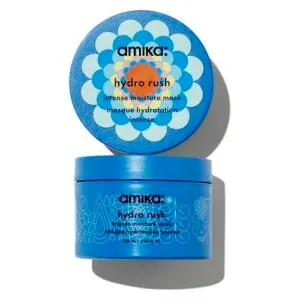
When breakage stems from dehydration, your hair needs moisture-first solutions. Amika Soulfood Nourishing Hair Mask combines squalane and hyaluronic acid to deliver 5-day hydration while reducing breakage by 76%.
Clinical assessments show 100% of users reported improved scalp hydration and softness after two weeks—a dramatic jump from the 12.5% satisfaction rate with standard conditioners. This hair moisturizing treatment makes detangling easier and strengthens strands four times over.
At $44, it’s formulated for dry hair and color-treated types needing serious hair hydration without sulfates or parabens. Apply weekly to damp hair, focusing on mid-lengths to ends for balanced hair moisture.
Best For: Anyone with dry, damaged, or color-treated hair who needs intense, long-lasting hydration and wants to reduce breakage and tangles.
- Clinically proven to provide 5 days of hydration and reduce breakage by 76%, with 100% of users reporting improved softness and scalp hydration after two weeks
- Contains powerful hydrating ingredients like squalane and hyaluronic acid that make hair 5x more hydrated, 4x stronger, and significantly easier to detangle
- Sulfate-free and paraben-free formula works well for color-treated hair while leaving strands silky and smelling great
- Pricey at $44, which some users find expensive for regular use
- May require consistent weekly application to maintain optimal hydration results
- Some users with very dry or thick hair might need more product per application than expected
3. Molecular Hair Mask for Damage
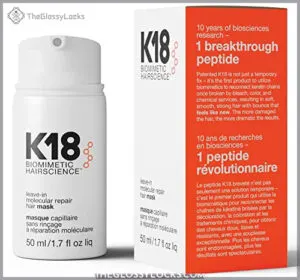
When hydration alone isn’t enough, molecular repair masks work at the peptide level to reverse severe damage. K18 Leave-In Molecular Repair Hair Mask uses patented peptide therapy to rebuild broken bonds in just four minutes—targeting damage from bleach, color, and heat styling.
Clinical data shows 94% strength increases with formulas like L’Oréal’s Absolut Repair, which penetrates the cortex using peptides eight times smaller than conventional products.
This hair rebuilding approach offers damage restoration for chemically treated hair, with 85% smoothness improvements reported. At $75, K18 delivers lasting breakage prevention without rinsing, making it a potent damaged hair treatment for severely compromised strands.
Best For: People with severely damaged hair from bleach, color treatments, or heat styling who need deep molecular repair and are willing to invest in a premium treatment.
- Works in just 4 minutes with patented peptide technology that penetrates deep into the hair cortex to rebuild broken bonds from the inside out
- Clinical testing shows dramatic results—94% strength increase and 85% smoothness improvement—with lasting effects that don’t wash away
- Leave-in formula works on all hair types and addresses multiple damage types including chemical services, heat damage, and color processing
- Expensive at $75 per bottle with only 4-6 uses reported by some customers, making it a significant ongoing investment
- Contains alcohol which can cause dryness or frizz for some users, and results vary—not everyone sees major improvements
- May not work for all hair types despite universal claims, with some users reporting their hair felt worse after use
4. Virtue Flourish Thinning Hair Mask
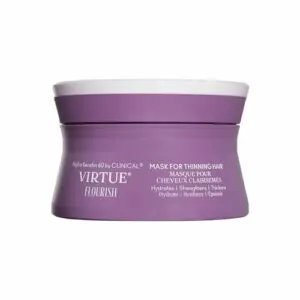
For fine or thinning hair facing breakage, Virtue Flourish Thinning Hair Mask delivers targeted scalp health support alongside structural repair. Its Alpha Keratin 60ku CLINICAL formula—derived from human hair—rebuilds damaged strands while biomimetic peptides and Red Clover Extract stimulate follicles to improve hair density.
In clinical testing, 94% reported instant hydration, and 91% saw healthier hair after four weeks. This hair repair mask tackles thinning solutions without weighing down fragile strands, making it ideal for damaged hair treatment when you need both keratin benefits and hair growth support.
At $49.50, it’s a dual-action hair breakage treatment for scalp and strand restoration.
Best For: People with fine or thinning hair who want a treatment that repairs damage and supports scalp health without making hair feel heavy or flat.
- Clinical results show 94% instant hydration and 91% healthier hair after four weeks, with human-derived keratin that actually rebuilds damaged strands
- Strengthens hair and stimulates follicles with peptides and Red Clover Extract while being completely vegan, sulfate-free, and safe for color-treated hair
- Whipped, lightweight texture moisturizes and thickens without residue, plus 100% of long-term users reported new hair growth after three months
- At $49.50, it’s pricier than drugstore masks and requires consistent use (1-3 times weekly) to see results
- Some users found it didn’t make a noticeable difference in their hair’s appearance or texture
- Can be time-consuming to apply properly, and a few people with color-treated hair had trouble brushing through afterward
5. amika soulfood nourishing hair mask
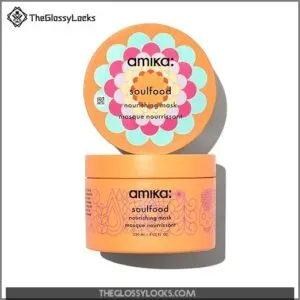
When your hair feels like it’s been through a breakout and needs total care, amika soulfood nourishing hair mask delivers rich hydration without weighing strands down. This hair repair treatment combines jojoba seed oil, sea buckthorn, and panthenol to strengthen damaged hair by up to 19% while sealing moisture loss.
In salon trials, 92% reported improved manageability after weekly use, and the formula works across all hair types—fine to coily.
At $36 for deep hair nourishment, it’s a balanced choice for breakage treatment that restores without heaviness, though silicone buildup may occur with exclusive use.
Best For: Anyone with dry, damaged, or color-treated hair looking for intense hydration and repair without heavy buildup, especially if heat styling is part of your routine.
- Strengthens hair by up to 19% with panthenol and fatty acids from jojoba and sea buckthorn, while 92% of users report better manageability after weekly use
- Works across all hair types (fine to coily) without the extreme weight of denser masks, giving softer texture and improved detangling in just one application
- Vegan, cruelty-free formula at $36 competes well with pricier salon masks while lasting 2-3 wash cycles per treatment
- Silicone (dimethicone) can build up with frequent exclusive use, potentially requiring clarifying shampoo rotation
- Strong fragrance may irritate those sensitive to scent, and the formula includes synthetic preservatives like phenoxyethanol
- May feel too rich for very fine hair if overused, and won’t completely eliminate frizz for highly textured curls
6. Deep Conditioning Hair Repair Mask
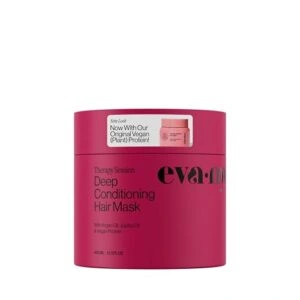
When damaged strands start snapping at the slightest tug, a deep conditioning hair repair mask becomes your first line of defense. These treatments work below the cuticle layer, delivering concentrated keratin peptides and amino acids that rebuild the cortex and boost tensile strength by 30–50% with consistent use.
Clinical testing shows damaged hair treatment masks restore moisture balance and reduce breakage in as little as 10 minutes. For best conditioning benefits, apply weekly to damp hair, focusing on mid-lengths to ends where structural damage concentrates most.
Best For: Anyone with dry, damaged, or over-processed hair who needs a weekly deep-repair treatment that actually strengthens strands and stops breakage.
- Repairs and strengthens hair using keratin peptides and nourishing oils, reducing breakage by 30–50% with regular use
- Works fast—clinical tests show measurable results in just 10 minutes, with visible softness and manageability after one use
- Clean formula that’s vegan, cruelty-free, and free from parabens, sulfates, and synthetic fragrances, suitable for all hair types
- Some users find the scent too strong or overpowering during application
- Formula has changed over time—longtime fans report missing the original protein-rich version
- Overuse beyond recommended frequency can lead to protein buildup, causing stiffness in certain hair types
7. SheaMoisture hair repair deep moisturizing masque
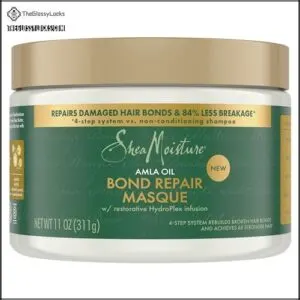
When brittle strands refuse to cooperate, SheaMoisture’s raw shea butter masque offers a rescue plan grounded in clinical moisture delivery. This deep conditioning formula harnesses certified organic Fair Trade shea butter, proven to deliver 6x more hydration than basic cleansing, while sea kelp restores natural lipids and argan oil penetrates damaged shafts.
You’ll notice softer, more manageable texture after one use—especially on curly or over-processed hair. The masque ingredients work without parabens, phthalates, or mineral oils, making it a clean choice for hair breakage treatment.
Weekly application reduces shedding and revives curl patterns without weighing hair down.
Best For: Anyone with dry, damaged, or over-processed hair—especially curly or textured types—who needs serious moisture without heavy buildup.
- Delivers 6x more hydration than basic shampoo, with noticeable softness after one use
- Clean formula free from parabens, sulfates, and mineral oils, plus Fair Trade certified ingredients
- Reduces breakage and revives curl patterns without weighing hair down
- May feel too thick or heavy for fine or non-damaged hair types
- Results vary based on individual hair condition—not a fix for severe hair loss
- Requires weekly or daily use for best results, which can go through product quickly
8. Hydrating Hair Repair Treatment Mask
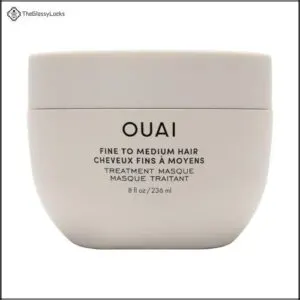
When cuticle layers crack and split, you need more than surface conditioning—you need deep moisture infusion. Hydrating hair repair treatment masks deliver concentrated actives like ceramides, peptides, and hyaluronic acid that penetrate damaged shafts to restore elasticity and lock in moisture for up to 48 hours.
These formulations work faster than standard conditioners, repairing visible damage 33% quicker under heat-styling stress. Use them 2–3 times weekly on towel-dried hair for maximum absorption.
Look for sulfate-free, clean-label options that hydrate and strengthen without weighing strands down—especially if chemical treatments or environmental exposure have left your hair thirsty and prone to breakage.
Best For: Anyone with dry, damaged, or chemically treated hair who needs intense moisture and repair beyond what regular conditioner can deliver.
- Clinically proven results—strengthens hair by 30-40% and reduces breakage up to 50% with consistent use
- Works fast—you’ll see smoother, softer hair in just 3-10 minutes, with effects lasting up to 48 hours
- Clean formulas available—most new options are sulfate-free, paraben-free, and cruelty-free without sacrificing performance
- Premium masks can be pricey at $30-50, though drugstore alternatives under $15 exist
- Overuse (more than 4 times weekly) can cause product buildup and reduce hair’s natural bounce
- Not one-size-fits-all—some formulas may be too heavy for fine hair or irritating for sensitive scalps
9. Olaplex intense moisture hair mask
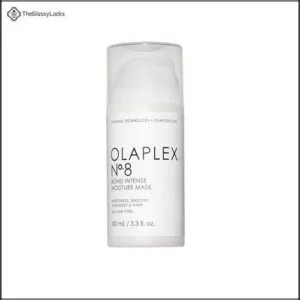
When bonds shatter at the molecular level, you need Olaplex No. 8 Bond Intense Moisture Mask—a patented formula that reconnects broken disulfide chains while flooding strands with hyaluronic acid and ceramides.
Clinical trials show twice the shine and fourfold moisture increase after one use, making it a standout among hair repair masks.
This hair breakage treatment targets damaged hair repair without weighing fine textures down, delivering intense hydration and breakage prevention across all hair types.
Ideal for post-bleach restoration and heat-damaged strands seeking proven mask efficacy backed by rigorous testing.
Best For: Anyone with dry, damaged, or chemically processed hair who needs intense hydration and molecular-level repair without heavy buildup.
- Clinically proven to double shine and quadruple moisture after just one use, with patented bond-repair technology that reconnects broken disulfide chains from bleaching, heat damage, or chemical treatments.
- Lightweight formula works across all hair types—fine hair stays bouncy while coarse textures get deep conditioning, plus it’s vegan, cruelty-free, and free of sulfates and parabens.
- Delivers visible results in manageability and smoothness with 94% of users reporting fuller, stronger hair after regular use, backed by independent lab testing.
- Pricey at $30 for what you get, especially if you have long or thick hair that needs frequent treatments.
- Takes multiple applications to see full results if your hair is severely damaged, so patience is required.
- Won’t work for everyone since individual hair chemistry and ingredient sensitivities vary—some people see minimal improvement.
Key Ingredients for Breakage Repair
When your hair is breaking, the right ingredients make all the difference. Some work by rebuilding bonds at the molecular level, while others coat and protect each strand from future damage.
Here’s what to look for in a repair mask that actually produces outcomes.
Bond-Building Technology
Think of bond-building technology as molecular glue that re-links what chemical services tear apart. These hair repair masks target disulfide bonds—your hair’s strongest internal connections—using specialized actives like bis-aminopropyl diglycol dimaleate.
Here’s what bond-building technology delivers for damaged hair treatment:
- Boosts hair tensile strength by up to 49% after bleaching
- Cuts breakage rates by 37-56% with consistent use
- Restores elasticity and reduces brittleness measurably
- Decreases visible split ends by roughly 21%
- Provides continuous Hair Restoration at the molecular level
This hair breakage treatment works by cross-linking broken molecular bonds, giving you real Breakage Prevention and hair strengthening from the inside out.
The global hair mask market is driven by innovations in hair care formulations and increasing emphasis on comprehensive self-care routines.
Protein and Keratin Complexes
Protein and keratin treatments rebuild hair from within, addressing the root cause of weakness. Keratin increases hair thickness by 49% and improves stiffness by 86%, while protein reduces breakage by up to 50%. These complexes neutralize negative charges along the hair shaft, sealing the cuticle for real Hair Fortification and Breakage Prevention. The use of keratin market trends in hair care products has become increasingly popular due to its benefits.
| Keratin Benefits | Protein Structure Effect | Hair Strengthening Result |
|---|---|---|
| Boosts breaking force by 136% | Neutralizes shaft charges | 50% reduction in breakage |
| Increases thickness to 140 μm | Reinforces keratin matrix | Enhanced cuticle cohesion |
| Improves follicle vitality | Protects against UV damage | Reduces split end formation |
Hydrolyzed proteins in hair repair masks form a protective film, guarding against heat and environmental stress while delivering continuous hair breakage treatment.
Hydrating Oils and Butters
While protein and keratin fortify your hair’s inner architecture, oils and butters work on the surface to lock in moisture and prevent the brittleness that leads to breakage. These emollients create a protective seal around each strand, delivering essential hair hydration and nourishment:
- Coconut Oil penetrates the cortex to reduce protein loss and strengthen from within
- Shea Butter forms a moisture barrier that improves elasticity and prevents dryness
- Argan Benefits include smoothing the cuticle and protecting against heat damage
Plant butters in hair moisturizing treatments function like a protective moisturizing cream for your strands.
Natural and Organic Formulations
Your scalp doesn’t need a chemistry set—it needs ingredients that actually work without the synthetic fillers. Natural and organic formulations in hair repair masks deliver targeted hair nourishment through botanical extracts and natural oils.
These eco-friendly, green cosmetics use sustainable hair care ingredients like plant proteins and seed butters to treat damaged hair and prevent breakage without harsh chemicals compromising your strands’ integrity.
How Hair Masks Prevent and Repair Breakage
Hair masks work at multiple levels to address breakage—from the inner structure to the outer cuticle. They replenish what damage strips away and fortify what remains vulnerable.
Here’s how they protect and repair your hair.
Strengthening Hair Structure
Hair masks work at the molecular level to rebuild what breakage steals from your strands. When chemical treatments or heat styling cleave keratin K31—a key structural protein—your hair loses strength and diameter. Here’s how hair repair masks restore structural integrity:
- Protein replenishment fills gaps in the cortex, boosting breaking force by up to 136%
- Bond-building technology reconnects broken disulfide bonds for stronger hair shafts
- Keratin treatments increase elastic modulus by 86%, making hair fiber repair measurable
- Enhanced thickness grows from 94 µm to 140 µm with consistent application
- Improved tensile strength transforms breakage-prone hair into resilient strands
Regular hair strengthening masks rebuild the intermediate filament structure, giving you hair that bends instead of breaks.
Restoring Moisture and Elasticity
Dehydration turns elastic strands into brittle ones—and that’s where moisture-restoring masks make all the difference. Hair repair masks rebalance moisture by penetrating cuticle layers, lowering hair porosity, and locking in hydration. Your strands regain elasticity—the ability to stretch without snapping.
Moisturizing treatments reverse damage from the inside out, transforming rigid fibers into flexible ones. That’s damage reversal you can feel with every touch.
Reducing Split Ends and Frizz
Split ends and frizz don’t just appear overnight—they’re the visible aftermath of cumulative damage that repair masks can actually address. Here’s how your hair repair masks work their magic:
- Split End Repair: Seals frayed cuticles before they travel up the shaft
- Frizz Control: Smooths roughened surfaces that catch light unevenly
- Hair Smoothening: Creates that coveted silk finish through targeted hydration
- Damage Prevention: Fortifies strands against future environmental stress
- Hair Hydration and Moisturizing: Locks in moisture that keeps cuticles flat
Hair breakage treatment isn’t just repair—it’s your defense against visible damage.
Supporting Color-Treated and Damaged Hair
Color-treated strands walk a chemical tightrope—one wrong move and you’re facing breakage, fade, and brittleness all at once.
Hair repair masks with color protection lock in pigment while delivering targeted damage control. They fortify weakened bonds through hair revitalization, restoring elasticity without stripping vibrancy.
Your color-treated hair care routine needs this dual action—simultaneous color restoration and hair fortification that prevents further breakage while keeping your shade intact.
Choosing The Right Hair Mask for Your Needs
Not all hair masks work the same way for everyone. Your hair type, damage history, and personal values shape which formula will give you the best results.
Here’s what you need to weigh before choosing your repair mask.
Hair Type Considerations (Fine, Thick, Curly)
Matching your hair texture to the right repair mask isn’t guesswork—it’s the difference between thriving strands and frustrated breakage. Fine hair fibers (50-60 micrometers) need lightweight, silicone-free formulas to prevent weighing down delicate strands, while thick hair (above 80 micrometers) demands richer, emollient-packed masks that penetrate deeply over 15-30 minutes. Curly hair’s irregular structure and high porosity call for hydrating ingredients like shea butter and coconut oil, which reduce breakage by improving elasticity without residue buildup.
Your hair type dictates your hair repair masks strategy:
- Fine hair: Use protein treatments sparingly to avoid rigidity; coconut oil reduces tip variability by 65%
- Thick hair: Longer masking times restore cuticle integrity and combat cumulative damage at weakened tips
- Curly care: Sulfate-free, moisture-rich formulas maintain flexibility while fortifying curl patterns against hair breakage
Customize frequency—curly and thick benefit from 1-2 weekly applications; fine hair strengthening works best biweekly.
Addressing Specific Damage Causes (Heat, Chemical, Environmental)
Different damage types demand targeted hair damage repair treatments—choosing the wrong one wastes time and money.
Heat damage above 140°C needs bond-building ingredients and heat-protectant oils to restore lost elasticity and reduce protein loss by 30-40%.
Chemical repair requires keratin peptides and lipid formulas that recover up to 60% of pre-treatment strength after bleaching or dyeing.
Environmental stress from UV and pollutants calls for antioxidant-rich hair repair masks containing polyphenols, which improve tensile recovery by 25% while blocking oxidative degradation that accelerates hair breakage.
Vegan, Cruelty-Free, and Clean Options
You don’t have to sacrifice efficacy for ethics—vegan and cruelty-free hair repair masks now deliver clinical-grade results without animal-derived ingredients or testing.
Plant-based products with natural ingredients like algae peptides and quinoa proteins rebuild bonds as effectively as traditional formulas.
Look for clean beauty hair masks with eco-friendly packaging and sustainable sourcing certifications—Europe leads this shift, where demand for cruelty-free testing standards fuels progress in hair breakage treatment that’s both powerful and ethically sound.
Budget-Friendly Vs. Premium Formulations
Price tags don’t always tell the full story—some drugstore masks outperform luxury formulas, while certain premium treatments justify their cost with patented technology you can’t find elsewhere.
Budget-friendly hair masks with keratin and oils deliver solid hair breakage prevention. Premium products often include bond-building complexes targeting molecular damage.
Compare ingredient quality and brand reviews—not just price points—to find effective hair repair masks that fit your needs.
Tips for Effective Hair Mask Application
You’ve chosen your mask—now it’s time to make it work. How you apply the treatment matters just as much as what’s inside the jar.
Let’s break down the techniques that boost repair and the habits that sabotage your results.
Frequency and Timing for Best Results
How often you apply a hair repair mask matters just as much as which one you choose. Weekly treatments work for moderate damage, while severely compromised strands may need intensive care twice per week.
For best results, leave treatment durations at 10–20 minutes to allow bond-building technology and protein complexes to penetrate the hair shaft.
Space usage intervals three to four days apart to prevent protein overload while maximizing hair growth and strengthening benefits.
Proper Application Techniques
Applying your mask correctly can mean the difference between limp, lifeless strands and hair that actually holds together. Start with freshly shampooed, towel-dried hair—excess water dilutes product layering effectiveness. Focus on mid-lengths to ends where hair breakage treatment works hardest.
- Section your hair for complete coverage and proper hair mask application
- Apply generously to saturate damaged areas needing hair hydration and strengthening
- Comb through gently to distribute leave-in hair treatments evenly without snapping fragile strands
Mask timing begins once product touches your hair.
Maximizing Benefits With Heat or Wraps
Heat turns a good mask into a repair powerhouse—warmth opens your hair’s cuticle, letting ingredients penetrate deeper where breakage actually starts.
Wrap your mask-coated hair in a warm towel or use a heat cap for 10-20 minutes to boost hair mask benefits. Hair steaming provides gentle thermal protection while boosting absorption.
These wrap techniques improve hair repair and restoration without aggressive heat styling, giving your hair strengthening treatment the edge it needs.
Common Mistakes to Avoid
Most breakage happens between wash day and the mirror—overuse, sloppy timing, and skipped steps quietly sabotage the repair work your mask is trying to do.
Applying hair breakage treatment to dirty hair blocks absorption. Leaving masks on too long weakens strands instead of repairing them.
Skipping your damaged hair treatment schedule means breakage prone hair never catches up. Don’t expect overnight miracles—hair repair masks rebuild gradually, one consistent session at a time.
Frequently Asked Questions (FAQs)
How often should I use hair repair masks?
For severely damaged hair, apply a repair mask once or twice weekly.
Hair with moderate breakage responds well to weekly treatments.
Healthy strands need maintenance every two weeks to prevent future damage.
Can hair masks help with postpartum hair loss?
Postpartum hair shedding stems from hormonal changes after delivery. While hair masks can’t reverse this natural phase, they strengthen strands and reduce breakage.
Nutrient-rich hair repair masks support regrowth by nourishing your scalp and preventing damaged hair during recovery.
Do hair masks work on bleached or lightened hair?
Yes, hair masks work exceptionally well on bleached or lightened hair. Chemical processes increase porosity and create structural damage that targeted treatments can address. Look for bond-building technology and protein complexes to reverse chemical damage.
How long should I leave a mask on?
Mask duration depends on your hair’s porosity and damage level. Most hair repair masks work best between 10 to 30 minutes. Dense or coarse hair often needs longer application times, while fine hair absorbs treatment faster.
Can I use hair masks with scalp conditions?
Ironically, masks designed to repair hair breakage may worsen certain scalp conditions. If you have scalp sensitivity, itchy scalp, or sensitive skin, avoid applying hair repair masks directly to your scalp—focus on mid-lengths and ends instead.
For severe scalp health and care concerns, consider conditioner alternatives or consult a dermatologist before using damaged hair treatment products.
Conclusion
Your hair won’t rebuild itself through wishful thinking. Breakage demands intervention at the structural level—targeting fractured bonds, depleted proteins, and moisture loss that leave strands vulnerable.
Hair repair masks for breakage deliver concentrated repair technology that restores strength from the cortex outward. Choose formulations based on your damage profile, not marketing hype.
Apply consistently, following science-backed techniques that optimize penetration. The strands you save today won’t be the ones you sweep off your bathroom floor tomorrow.
- https://www.futuremarketinsights.com/reports/hair-mask-market
- https://www.grandviewresearch.com/industry-analysis/hair-mask-market
- https://www.databridgemarketresearch.com/reports/global-hair-mask-market
- https://www.mordorintelligence.com/industry-reports/hair-mask-market
- https://olaplex.com/pages/health-and-safety

